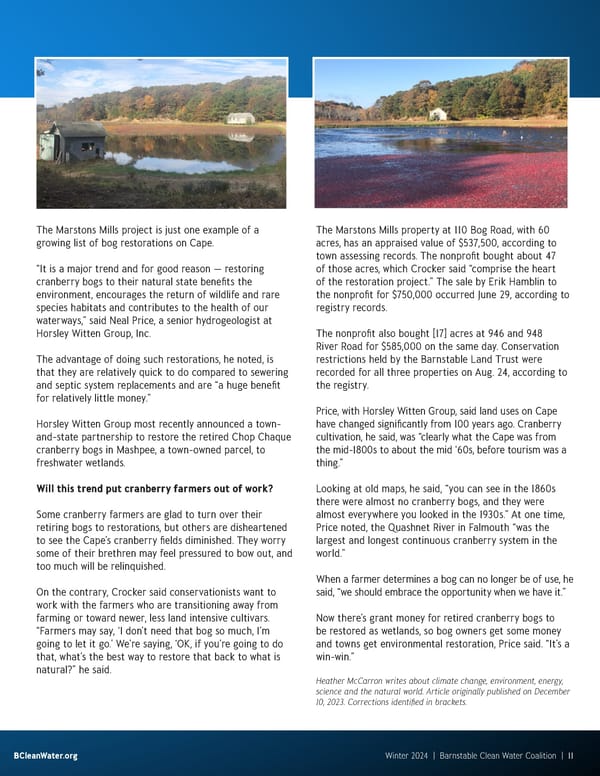The Marstons Mills project is just one example of a The Marstons Mills property at 110 Bog Road, with 60 growing list of bog restorations on Cape. acres, has an appraised value of $537,500, according to town assessing records. The nonpro昀椀t bought about 47 “It is a major trend and for good reason — restoring of those acres, which Crocker said “comprise the heart cranberry bogs to their natural state bene昀椀ts the of the restoration project.” The sale by Erik Hamblin to environment, encourages the return of wildlife and rare the nonpro昀椀t for $750,000 occurred June 29, according to species habitats and contributes to the health of our registry records. waterways,” said Neal Price, a senior hydrogeologist at Horsley Witten Group, Inc. The nonpro昀椀t also bought [17] acres at 946 and 948 River Road for $585,000 on the same day. Conservation The advantage of doing such restorations, he noted, is restrictions held by the Barnstable Land Trust were that they are relatively quick to do compared to sewering recorded for all three properties on Aug. 24, according to and septic system replacements and are “a huge bene昀椀t the registry. for relatively little money.” Price, with Horsley Witten Group, said land uses on Cape Horsley Witten Group most recently announced a town- have changed signi昀椀cantly from 100 years ago. Cranberry and-state partnership to restore the retired Chop Chaque cultivation, he said, was “clearly what the Cape was from cranberry bogs in Mashpee, a town-owned parcel, to the mid-1800s to about the mid ‘60s, before tourism was a freshwater wetlands. thing.” Will this trend put cranberry farmers out of work? Looking at old maps, he said, “you can see in the 1860s there were almost no cranberry bogs, and they were Some cranberry farmers are glad to turn over their almost everywhere you looked in the 1930s.” At one time, retiring bogs to restorations, but others are disheartened Price noted, the Quashnet River in Falmouth “was the to see the Cape’s cranberry 昀椀elds diminished. They worry largest and longest continuous cranberry system in the some of their brethren may feel pressured to bow out, and world.” too much will be relinquished. When a farmer determines a bog can no longer be of use, he On the contrary, Crocker said conservationists want to said, “we should embrace the opportunity when we have it.” work with the farmers who are transitioning away from farming or toward newer, less land intensive cultivars. Now there’s grant money for retired cranberry bogs to “Farmers may say, ‘I don’t need that bog so much, I’m be restored as wetlands, so bog owners get some money going to let it go.’ We’re saying, ‘OK, if you’re going to do and towns get environmental restoration, Price said. “It’s a that, what’s the best way to restore that back to what is win-win.” natural?” he said. Heather McCarron writes about climate change, environment, energy, science and the natural world. Article originally published on December 10, 2023. Corrections identi昀椀ed in brackets. BCleanWater.org Winter 2024 | Barnstable Clean Water Coalition | 11
 BCWC Fall23Winter24 Newsletter Page 10 Page 12
BCWC Fall23Winter24 Newsletter Page 10 Page 12